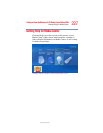
230
Using the TOSHIBA RAID Utility
Using RAID
5.375 x 8.375 ver 2.3
RAID-1
RAID-1 improves reliability in storing data by automatically
copying all data from your computer’s primary internal hard
disk to your computer’s secondary internal hard disk.
If your computer’s primary hard disk fails, you can replace
the failed primary hard disk with the secondary hard disk that
contains the mirrored data. See “Restoring a failed drive in a
RAID-1 array” on page 251.
RAID-1 is configured by creating an array which specifies
the hard disk to be copied, and the hard disk to which the data
will be copied. For your computer, an array will consist of the
computer’s primary internal hard disk and the computer’s
secondary internal hard disk.
The process of copying data from the primary hard disk to the
secondary hard disk is referred to as mirroring, and the array
itself is referred to as a mirror. If you want to discontinue the
process of mirroring, this is referred to as breaking a mirror.
For more information, see “Breaking a RAID-1 array
(mirror)” on page 248.
If both hard disk drives fail simultaneously, such as during a
power failure, the mirrored data on the secondary hard disk
may not be identical to the data on the primary hard disk.
To create a RAID-1 array, you must use a secondary internal
hard disk with a capacity equal to or greater than that of the
computer’s primary internal hard disk. For example, if the
primary internal hard disk is 40 GB, then the secondary
internal hard disk must be 40 GB or greater.
When RAID-1 is configured, the operating system will
display the smaller of the two hard disk drives defined in the
array as the computer’s total hard disk capacity. For example,
when a RAID-1 array is configured with one 40 GB hard disk
drive and one 80 GB hard disk drive, the computer’s total


















